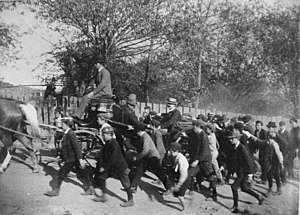
Back Anthrazit-Streik German Pennsylvanian hiilikaivostyöläisten lakko 1902 Finnish Grève du charbon de 1902 French Sciopero del carbone del 1902 Italian Antracytowy strajk Polish Пенсильванская стачка горняков (1902) Russian Штрајк рудара угља 1902. Serbian
| Coal strike of 1902 (Anthracite coal strike) | |||
|---|---|---|---|
 John Mitchell, President of the UMWA, arriving in Shenandoah surrounded by a crowd of breaker boys. | |||
| Date | May 12 – October 23, 1902 | ||
| Location | |||
| Goals | Eight-hour workday, higher wages, and union recognition | ||
| Methods | Striking | ||
| Resulted in | Nine-hour workday (reduced from ten) wage increase of 10% first strike settled by federal arbitration | ||
| Parties | |||
| |||
| Lead figures | |||
John Mitchell George Baer | |||
| Number | |||
| |||
| Settlement arbitrated by Theodore Roosevelt's administration | |||
The Coal strike of 1902 (also known as the anthracite coal strike)[1][2] was a strike by the United Mine Workers of America in the anthracite coalfields of eastern Pennsylvania. Miners struck for higher wages, shorter workdays, and the recognition of their union. The strike threatened to shut down the winter fuel supply to major American cities. At that time, residences were typically heated with anthracite or "hard" coal, which produces higher heat value and less smoke than "soft" or bituminous coal.
The strike never resumed, as the miners received a 10 percent wage increase and reduced workdays from ten to nine hours; the owners got a higher price for coal and did not recognize the trade union as a bargaining agent. It was the first labor dispute in which the U.S. federal government and President Theodore Roosevelt intervened as a neutral arbitrator.[3]
- ^ "The Great Anthracite Coal Strike of 1902". Archived from the original on 2008-06-21. Retrieved 2008-07-14.
- ^ "The Pennsylvania Center for the Book - Great Anthracite Coal Strike of 1902". Archived from the original on 2013-05-15. Retrieved 2012-06-16.
- ^ Goodwin, Doris Kearns (2018). Leadership. Viking. Chapter Ten. ISBN 978 0 241 30071 8.